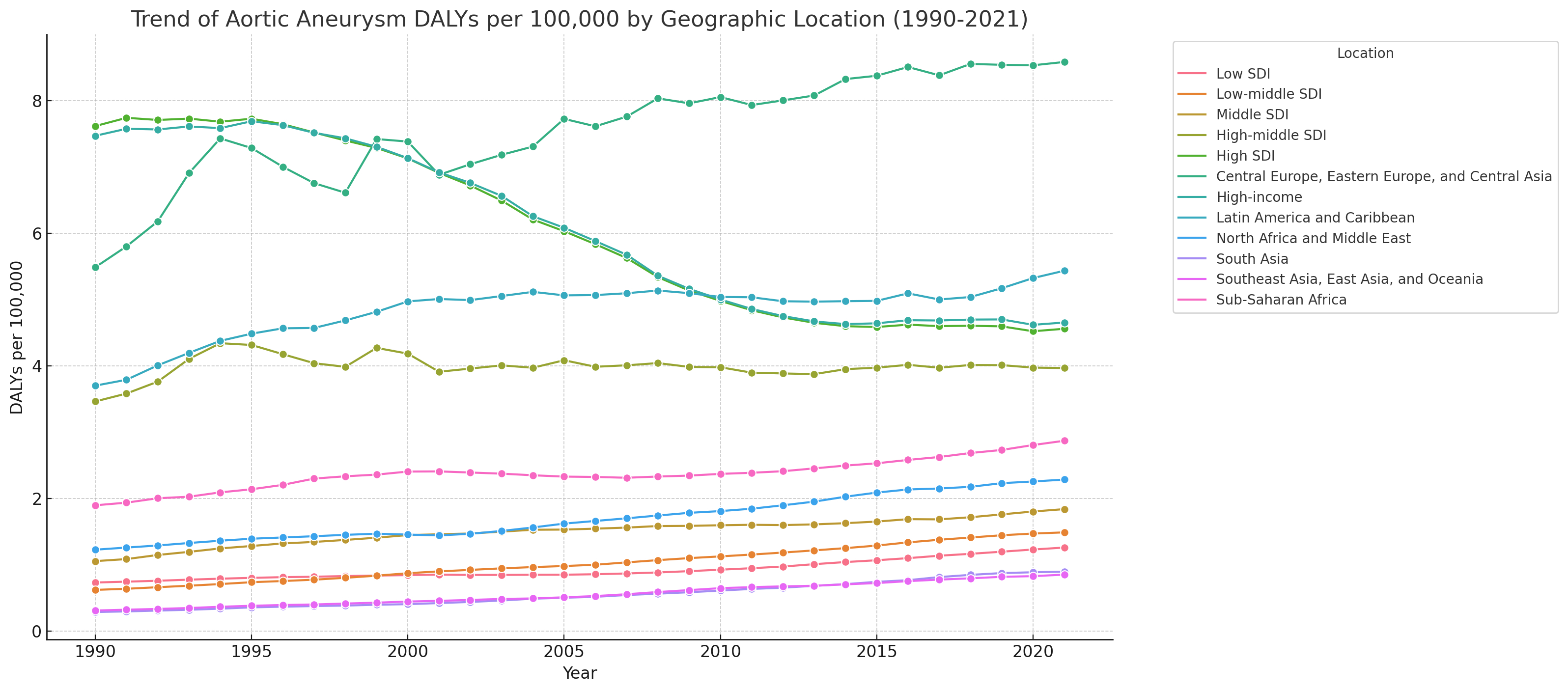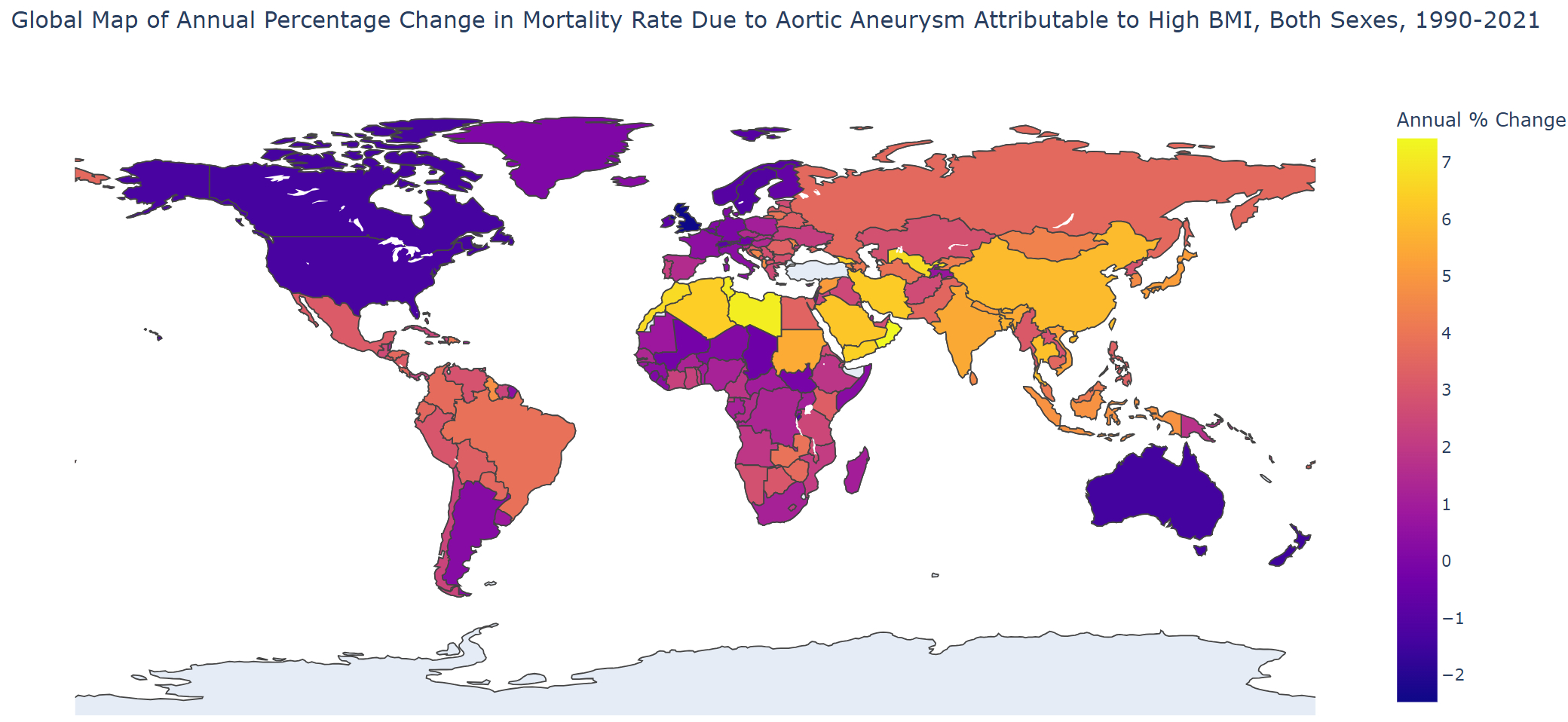Final ID: Tu0003
Trends and Impacts of High Body Mass Index on Global Aortic Aneurysm Burden from 1990-2021: Insight from Global Burden of Disease Study 2021
Abstract Body: Background and Aim: Aortic Aneurysm (AA) poses significant health risks globally, with its incidence often linked to various modifiable and non-modifiable factors. The global incidence of AA is increasing due to aging populations and modifiable lifestyle factors, with high Body Mass Index (BMI) identified as a key risk factor exacerbating AA through metabolic disorders, hypertension, and increased arterial wall stress, yet comprehensive global studies on its direct impact remain limited.
Method: Using global burden of disease 2021 tool, we estimated deaths and disability adjusted life years(DALYs) due to AA attributable h-BMI by age, sex, year and location across the 204 countries and territories.
Results: From 1990 to 2021, the global number of deaths due to AA attributable to h-BMI increased from 6,428 (95%UI: 3,450-10,799) to 11,539 (6,195-19,522), and DALYs rose from 137,241 (74,817-230,632) to 247,361 (134,536-414,707). Regionally, the highest annual percentage change (APC) in death counts was observed in high-income regions, increasing by 0.057% (4,604 of 5,255), while other regions showed a declining trend over the past three decades. Regarding DALYs, the greatest increase was in South Asia by 6.8%(1,731 of 13,663), followed by Southeast Asia, East Asia, and Oceania at 6.1% (3,765 of 23,976), lower-middle Socio-Demographic Index countries at 5.7% (1,699 of 6,839), and North Africa and the Middle East at 5.2% (2,317 of 11,271). By age, young to middle-aged adults (20-54 years) observed the highest increase in DALYs with an APC of 2.97% (24,294 of 57,025), followed by those under 70 years at 2.09% (79,032 of 150,458), and the 70+ age group at 1.65% (58,209 of 96,902). Over the last three decades, females experienced a higher increase in burden compared to males, with an APC in deaths of 2.21% (2,404 of 4,746) for females vs 1.7% (4,024 of 6,793) for males, and in DALYs of 2.14% (46,062 of 88,831) for females vs 1.18% (91,178 of 158,530) for males.
Conclusion: In 2021, deaths due to AA attributable to high BMI accounted for 7.49% of all AA causes globally. The burden has increased particularly in high-income regions, among middle-aged adults, and females over the past three decades. Technological advancements and lifestyle changes have significantly contributed to the rising prevalence of obesity, exacerbating the burden of AA. Public health initiatives should prioritize reducing this burden through improved management and targeted preventive strategies.
Method: Using global burden of disease 2021 tool, we estimated deaths and disability adjusted life years(DALYs) due to AA attributable h-BMI by age, sex, year and location across the 204 countries and territories.
Results: From 1990 to 2021, the global number of deaths due to AA attributable to h-BMI increased from 6,428 (95%UI: 3,450-10,799) to 11,539 (6,195-19,522), and DALYs rose from 137,241 (74,817-230,632) to 247,361 (134,536-414,707). Regionally, the highest annual percentage change (APC) in death counts was observed in high-income regions, increasing by 0.057% (4,604 of 5,255), while other regions showed a declining trend over the past three decades. Regarding DALYs, the greatest increase was in South Asia by 6.8%(1,731 of 13,663), followed by Southeast Asia, East Asia, and Oceania at 6.1% (3,765 of 23,976), lower-middle Socio-Demographic Index countries at 5.7% (1,699 of 6,839), and North Africa and the Middle East at 5.2% (2,317 of 11,271). By age, young to middle-aged adults (20-54 years) observed the highest increase in DALYs with an APC of 2.97% (24,294 of 57,025), followed by those under 70 years at 2.09% (79,032 of 150,458), and the 70+ age group at 1.65% (58,209 of 96,902). Over the last three decades, females experienced a higher increase in burden compared to males, with an APC in deaths of 2.21% (2,404 of 4,746) for females vs 1.7% (4,024 of 6,793) for males, and in DALYs of 2.14% (46,062 of 88,831) for females vs 1.18% (91,178 of 158,530) for males.
Conclusion: In 2021, deaths due to AA attributable to high BMI accounted for 7.49% of all AA causes globally. The burden has increased particularly in high-income regions, among middle-aged adults, and females over the past three decades. Technological advancements and lifestyle changes have significantly contributed to the rising prevalence of obesity, exacerbating the burden of AA. Public health initiatives should prioritize reducing this burden through improved management and targeted preventive strategies.
More abstracts on this topic:
A Randomized Placebo-Controlled Trial of Pitavastatin Calcium to Treat Combined Dyslipidemia of Obesity in Adolescents – The Pediatric Heart Network Dyslipidemia of Obesity Intervention in Teens (DO IT!) Trial
De Ferranti Sarah, Cartoski Mark, Brothers Julie, San Giovanni Christine, Zachariah Justin, Pena Sandra, Mahle William, Peterson Amy, Magge Sheela, Raghuveer Geetha, Sharma Binu, Arslanian, Md Silva, Kazlova Valiantsina, Sponseller Craig, Freemon Dandrea, Stylianou Mario, Mccrindle Brian, Mietus-snyder Michele, Urbina Elaine, Ware Adam, Teng Jessica, Trachtenberg Felicia, Russell Mark, Shah Amy
Accelerated Biological Aging, Early-Life Exposure to Tobacco, and Incident Aortic Aneurysm: A Large-Scale Prospective Cohort Study in UK BiobankYang Miaomiao, Feng Weijing, Dang Aimin, Gu Yingzhen



